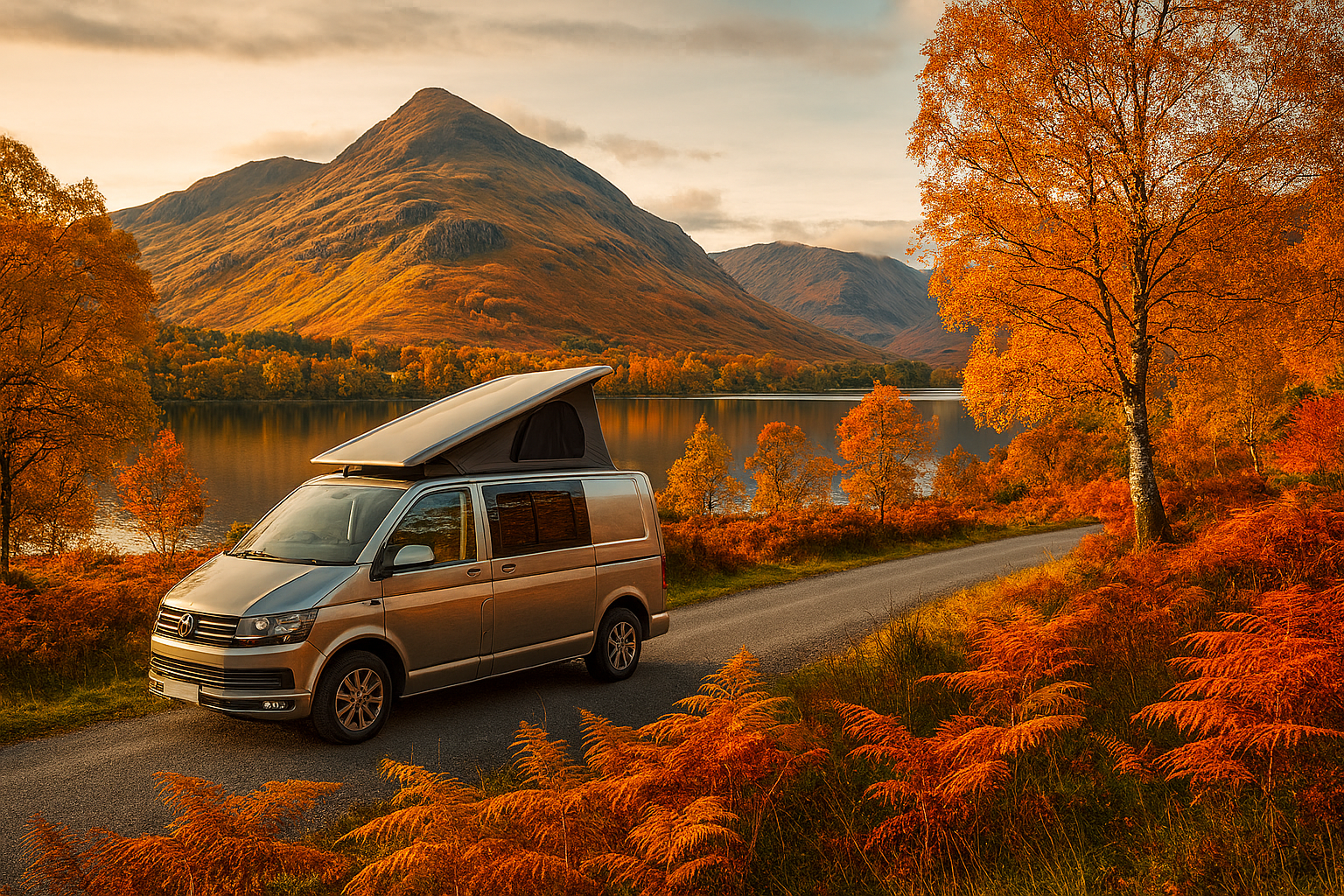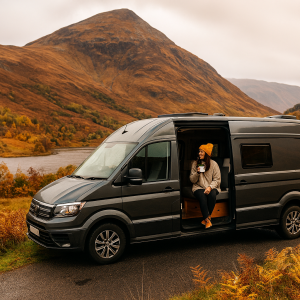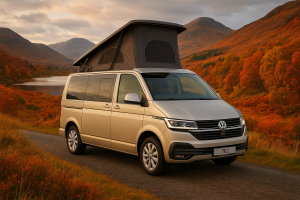
As the golden colours of autumn arrive and the crisp chill of winter sets in, many think it’s time to pack away the campervan until spring. Not so! At North Coast Campers, we believe the colder months offer some of the most dramatic and rewarding adventures, especially here in Scotland! However, prepping your van for lower temperatures is absolutely crucial, whether you plan to keep exploring or tuck it away for hibernation.
Here is our essential guide to both using and storing your campervan safely throughout autumn and winter.
Part 1: Continuing Your Adventures in the Cold 🏞☕
The great news is that most of our North Coast Campers conversions are built to conquer the cold! We focus on creating genuine year-round adventure vehicles:
• Warmth is Guaranteed: Most of our bespoke conversions come fitted with diesel night heaters (like the reliable Autoterm 2kw), ensuring your living space is toasty warm in minutes, no matter the weather outside. 🔥
• Triple Insulated Comfort: We pay special attention to keeping the heat in and the cold out. Our builds feature triple-layer insulation, giving you that ‘cosy cabin’ feeling all year round. 🧤
• Off-Grid Powerhouse: Forget struggling for hook-ups! Our electrical systems are frequently powered by off-grid lithium batteries. These high-performance systems let you run all your essentials—from your fridge and lights to your diesel heater and chargers—for longer, giving you the freedom to wild camp further off the beaten track. 🔋
Vehicle and Fuel Prep
• Check Your Tyres: Ensure your tyre pressure is correct and tread depth is adequate for potentially icy or wet roads. Consider fitting all-weather or winter tyres if you plan on driving in more severe conditions. 🥶
• Antifreeze and Screen Wash: Top up your engine coolant with the correct antifreeze mix and make sure your screen wash is rated for sub-zero temperatures. Visibility is everything!
• Gas Supply: This can be a good time of year to have your gas supply re-certified, making sure it’s safe for the following season.

Part 2: Essential Winterising for Storage 🛠💧
If you decide to park your van up for a while, the most important step is winterising the water system. Failure to do so can lead to frozen water, which expands and can cause thousands of pounds of damage to tanks, pipes, and taps. 💔
⚠ A Critical Warning for Underslung Water Tanks
Many modern campervans, including some conversion styles, feature tanks mounted under the vehicle chassis (underslung tanks) to save interior space. While excellent for space-saving, these tanks are highly vulnerable to freezing because they are exposed to the ambient temperature.
If you are storing your van and temperatures are expected to drop below freezing (0 °C or 32 °F), you MUST drain your underslung water tanks and pipes completely. 🚫🧊
How to Drain Your Water System (Winterisation)
• Turn Off the Water Pump: Locate the main switch and turn off your water pump. 💡
• Open All Taps: Open all hot and cold taps in your sink and shower (if fitted). Leave them open to relieve pressure and allow water to drain from the system.
• Drain the Tanks:
• Fresh Water: Locate the drain valve or plug on your fresh water tank and open it fully to let all the water out.
• Waste Water (Grey Tank): Open the drain valve on your grey waste tank and empty it completely. 🚽
• Empty the Water Heater (if applicable): If you have an in-line water heater or boiler, you will need to locate its specific drain valve and open it. Consult your heater’s manual for the correct procedure.
• Run the Pump (Briefly): After the main drainage, switch the pump back on very briefly (just a few seconds) with the taps still open. This helps push any residual water out of the lines. Do not run the pump for long without water in the system as this can cause damage!
• Protect the Toilet: If you have a built-in cassette toilet, empty the flush tank and cassette, and pour a small amount of non-toxic, food-safe antifreeze into the flush system to protect the pump seals.
Other Storage & Battery Tips (Crucial!)
• Lead Acid Battery Care: If your leisure system uses traditional Lead Acid batteries, you must be vigilant! They need to be fully charged at least every couple of weeks. You can do this by driving the van for a good, long run 🚗 or by plugging into a mains charger at the side of your house 🔌. Critically, a Lead Acid battery should never be allowed to drop below 12V as this will significantly shorten its life.
• Lithium Power: (A reminder if you have our lithium setup!) Lithium batteries are much more forgiving, but if storing for a long period, fully charge them before disconnecting, or use a trickle charger/solar panel.
• Fuel Tank: Fill your diesel tank to reduce condensation build-up inside the tank.
• Remove Valuables and Food: Clear all perishables, and remove items that are sensitive to cold, such as electronics, aerosols, and liquids. 🍎
• Handbrake: Avoid leaving the handbrake on for long periods in cold, wet conditions as the brake pads can freeze to the discs. Use wheel chocks instead. 🛑

Whether you’re hitting the trails or parking up for the season, a bit of preparation ensures your North Coast Campervan is protected and ready for your next adventure! Happy camping! 😊
Thinking of upgrading or starting your own build?
We now have availability for campervan conversions from December onwards—perfect timing to get your van ready for spring adventures or even a winter escape! ❄️🚐
Need advice on winter upgrades or a quote for a lithium power system? Contact the North Coast Campers team in Glasgow today! 📞